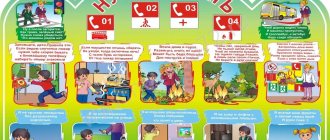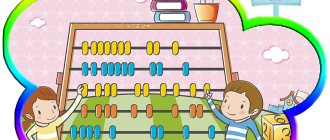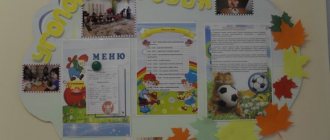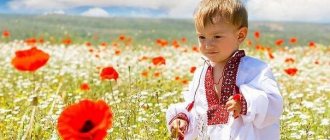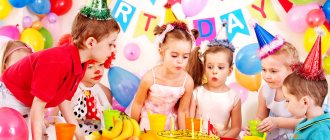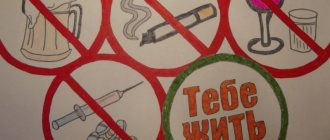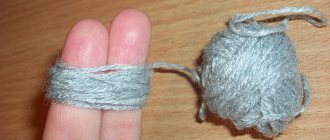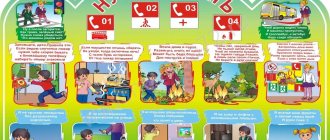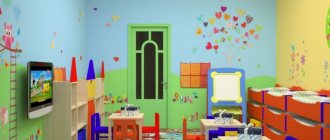What is it for?
Raising a patriot cannot be successful without referring to the culture and history of one’s region. Today, much of the life of our ancestors has been lost and forgotten, the way of life of the people has changed greatly, and we turn so little to our roots, but the unique culture of the Russian people has been formed over centuries and is full of various customs, traditions and rituals.
Knowledge and understanding of folk culture, the desire to join its further development in the future will become motives for active creative activity of a person if patriotic education begins from early childhood.
Decorating a patriotic corner in a kindergarten with your own hands will help teachers and parents organically introduce the child to the world around him, introduce him to his native culture, the eternal and the beautiful.
Rack for sports equipment
Decorating a sports corner with your own hands is done in the active games area. For bright hoops, clubs, balls and jumping ropes, it is necessary to organize aesthetic and convenient storage with special holders, nets and shelves.
To equip the corner, you need to use the safest plastic or fabric products.
The contents of the exhibition can be supplemented with homemade items, such as fake fishing rods or other devices for developing dexterity.
Where to start?
It is still difficult for kids who have just arrived in kindergarten to think in terms of a city, country, or culture. For them, the homeland is their immediate environment, so information about home and family that is accessible to children of this age should be contained in a patriotic corner in the kindergarten. The design of the 1st junior group requires a simple but bright design. It is important to attract children's attention and arouse their interest. At this age, speech is actively being formed, so everything should contribute to development, encourage the baby to recognize and name. Children can first simply observe the activities of adults who look at albums, naming all family members in the photos. Gradually, imitating adults, they themselves will begin to do this.
How to fill the patriotic corner in the nursery group?
This can be any material on social and moral development:
- Thematic folders containing illustrations with images of family members demonstrating their relationships, care, and joint affairs.
- Photo album “My Family” with images of pupils in a family environment.
- An album or exhibition “Here we live”, in which you can place photographs, illustrations or models of streets or various architectural buildings (kindergarten, school, houses where children live, other city objects).
- Exhibitions introducing the origins of Russian folk culture, which may contain a variety of antiquities, traditional toys (wooden and rag dolls), amulets, exhibits of decorative and applied art (painted nesting dolls, trays and other utensils with Gorodets, Khokhloma and Gzhel painting, Dymkovo toys , embroidered towels, scarves, knitted napkins, tablecloths and other items).
Fiction, works of folklore - songs, jokes, nursery rhymes and fairy tales - can also be placed in a patriotic corner in a kindergarten. The design of the nursery is meant to be colorful and understandable; it should not contain a lot of text; it is better if it is visual material that attracts the attention of children and their parents. It is important to remember the safety requirements, which are the same for all corners: all materials must be placed so that they cannot fall or injure the child. No sharp corners or edges are allowed.
Older children - tasks are more difficult
More complex concepts become accessible to the understanding of four-year-old children, therefore, complementing and developing the topics covered in younger groups, teachers and parents continue the direction of education we are considering, placing new materials in the patriotic corner in kindergarten. The design should influence the development of the child’s personality. It is important that not only literature, illustrations and teaching materials are used, but also elements of independent and joint activities. Preschoolers can play with friends or with adults, mastering the posted materials and making interactive connections.
The design of a patriotic corner in a kindergarten in the middle group should be beautiful, bright, attractive and interesting for children. There can be nothing damaged, broken or torn here. It’s good if the colors and shades used are correctly combined with each other and are pleasing to the child’s eye. All materials are updated from time to time.
In the middle group, most of the patriotic work takes place in and outside of class. These include purposeful walks along nearby streets and getting to know the administrative buildings located on them (shop, pharmacy, post office, etc.), reading fiction, talking with children about the nature of their hometown. All new information that children receive should be supported by materials in the patriotic corner.
Creation of a local history corner “Spring”
Nadezhda Shcherbakova
Creation of a local history corner “Spring”
Rodnichok , that’s what we called our local history corner in the middle group . Work on local history is one of the most important means of educating citizenship, forming the foundations of local history culture . Contributes to the formation of high moral qualities, such as respect for nature, patriotism, a sense of pride and love for one’s small Motherland. This goal is one of the most important tasks of our group - cultivating respect for the historical past of our city and region. Local history helps to see beauty in nature and find beauty in folk art . Studying your region exclusively, both educationally and cognitively. Getting to know the past, present and expected future of their small homeland, the peculiarities of the flora and fauna of the region, cultural and other conditions contributes to the formation of a civic position in children. For a small child, the feeling of the Motherland begins with the attitude towards his family, towards the people most dear and close to him - father, mother, grandmothers, grandfathers. We conducted a survey among parents to find out what they thought about the moral education of their children. Then they offered to take part in a project to study their region, its symbols, attractions, and those who glorified and glorify our region.
Having asked the parents to bring family photographs, we made a family album, which we called “My Home is My Fortress”, there are photographs of the closest and dearest people for the child. Many parents responded to our request and brought photos from their place of work. Children know the professions of their relatives and look at him with pleasure.
Alena P.’s mother gave us the coat of arms of Lipetsk, and we made a model of the monument to Peter the Great, they decorate our corner .
.
The family of R. Ilyusha made an album about the Voronezh River and its inhabitants. And in order to introduce children to the flora and fauna of the Lipetsk region, we designed albums about birds, animals and insects, and wrote projects.
.
Together with the children, we collected and made a herbarium of “plants from our kindergarten.”
In our corner, clay toys are carefully stored. Romanova, to find out how such toys are made, I went to the craft school, which is located in the Museum of Folk and Applied Arts . Here everyone can feel like a toy maker, and after completing training I was able to fashion whistle toys myself. Now our collection includes a duck, a cockerel, and a goat!
But these toys were brought to us by our parents from the village of Romanovo, where they are still sculpting Romanov toys.
These toys have visited exhibitions in different countries, glorifying our region.
The Lipetsk region is called the lace region, the city of Yelets is famous for this! Having created folders about this craft, the children learned new words: bobbins, weaving, lacemakers, etc.
And how many wonderful writers and their ancestors were born on our land (this is the grandmother of A. S. Pushkin, M. Yu. Lermontov)
The first Soviet writer, author of works about nature for children of different ages, M. Prishvin, poet Bunin, lived with us. L. We made the album “Great Names” about them and many others.
.
We have collected a small library with the works of our fellow countrymen.
to introduce children to Russian folk musical instruments through an exhibition that we made on a model of a balalaika (where we placed: a rattle, a whistle, bells, spoons, pipes)
everything Lipetsk
folk musicians .
Our parents helped us collect and arrange a collection of minerals from the Lipetsk region.
We must always remember those to whom we owe our lives on this earth, so we created a traveling folder with the heroes of the Second World War who lived in the Lipetsk region. (of course not all)
.
We took photographs with memorial places dedicated to the Second World War, so we will introduce children to the heroes and fellow countrymen.
All our work on local history is aimed at instilling a sense of pride in our city, in our family, in the people who have glorified and are glorifying our Lipetsk region.
Contents for the middle group
Children of this age will find the following materials interesting and useful for their development:
- illustrations of family holidays and traditions, fiction on moral themes;
- photographic materials, illustrations, albums, postcards, thematic folders introducing the history of the native city, its famous residents, and attractions;
- exhibits that introduce preschoolers to traditional culture: antique objects, folk toys, examples of decorative and applied arts, themed didactic games;
- works of folk art - from songs to fairy tales;
- symbols of the state, region and city.
What do we call home?
In older preschool age, the tasks of patriotic education become more complicated, children continue to get acquainted with their native land, study not only their city, but also the region and the country, receive information about state symbols, the historical past of Russia, and the national calendar.
The material placed in the patriotic corner in kindergarten also becomes more complex. The decoration is complemented by children's and family creative works. For example, while continuing to study the topic “My Family,” children and their parents create a family coat of arms or family tree. Family albums placed in the corner, which children love to look at and show to each other, will also be interesting.
Information board in children's institutions
When decorating a corner for parents with your own hands, the overall aesthetics of the institution are preserved. The composition, as a rule, is placed in the reception area, the most optimal place is above the changing lockers or at the entrance to the room.
A section of the wall is decorated with bright, cheerful drawings or wall relief figures, the details of which can be supplemented with seasonal or festive elements.
From hometown to country
Various materials on the following topics will help you continue your acquaintance with your hometown: “How did the city arise?”, “What is produced in our city?”, “The culture of my city,” “Famous fellow countrymen,” “During the Great Patriotic War,” “Sights” , "Architecture". Parents and educators can jointly create a selection of poems about the city.
The map of the locality and its symbols should also replenish the patriotic corner in the kindergarten. The design of an exhibition about the native land may contain symbols and a map of the region, information about its cities and famous places, and when children perceive this information, they will be ready to get to know their native country. Here you can’t do without a map of Russia. Modern printing produces special children's cards containing material accessible to children's understanding. And, of course, Russian symbols should appear in a prominent place - the coat of arms, flag, anthem and portrait of the president.
Subject developmental compositions in kindergartens
Exhibits with special paraphernalia on traffic rules, hygiene and healthy eating, shelves with musical instruments, books or pencils are also located in separate areas with a thematic design.
According to the requirements of modern pedagogy, privacy zones can also be created in playrooms and classrooms - houses, tents, curtained areas with upholstered furniture.
In the process of decorating corners with your own hands, you can use photo collections with successful solutions.
About culture, defenders of the Fatherland and planet Earth
In addition to local history information, other topics and areas contribute to patriotic education.
If the necessary material is available, information about how the culture of our people was born is posted in the patriotic corner. These could be thematic exhibitions “How did people live in Rus'?”, “What do ancient things tell about?”, “From the history of Russian folk costume”, “How did people walk and have fun?”, “Folk calendar” and others.
Information about the defenders of the Fatherland can also replenish the patriotic corner in kindergarten. The design (photo below) of exhibitions about the heroes of the Russian land, the Great Patriotic War and the Russian Army can arouse the interest of boys and instill in them a desire to become a defender of their homeland.
The global task of patriotic education is to form in children the concept that planet Earth is our common home, and everyone who lives on it should live in peace. Children need to be introduced to the living conditions of people in other parts of the planet, their customs and traditions.
If teachers and parents are interested in educating a young citizen, then the result will not be long in coming, and the corner of patriotic education will help in this.
